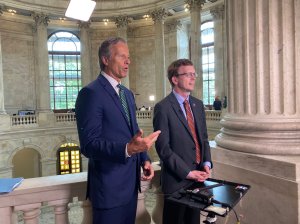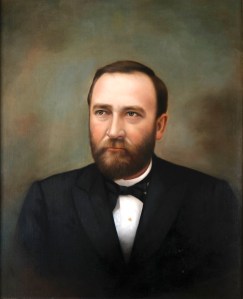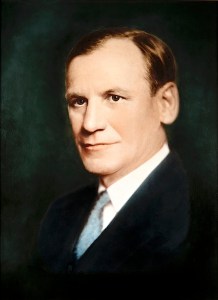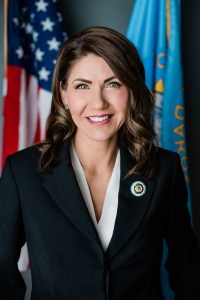This is an update of a post that was written prior to the 2020 general election.
The 2022 election marks twelve years since, in 2010, the South Dakota Republican Party began its current winning streak. That year, U.S. Senator John Thune won reelection unopposed – a first for a U.S. Senator from South Dakota. Kristi Noem defeated incumbent Congresswoman Stephanie Herseth Sandlin for a seat in the U.S. House of Representatives. Dennis Daugaard won his first term as Republicans made big gains in the State Legislature.

In 2022, SD Republicans are favored in every statewide race: U.S. Senator John Thune in a bid for a historic fourth term again challenger Brian Bengs, Congressman Dusty Johnson seeking a third term against a Libertarian opponent, Governor Kristi Noem and Lt. Governor Larry Rhoden facing Democrats Jamie Smith and Jennifer Keintz and a Libertarian slate, and down-ticket races for secretary of state, attorney general, state auditor, state treasurer, commissioner of school and public lands, and public utilities commissioner. (The attorney general race is unopposed, as former AG Marty Jackley will return to his former office in January.)
Although the current Republican winning streak is unusual to the modern observer, there have been several longer multi-year winning streaks in South Dakota’s history, all achieved by the Republican Party. (These streaks include statewide elections for President, federal offices, and state offices. They also include U.S. House elections that were conducted by district, at the time when South Dakota had more than one U.S. House seat).
Here are the longest winning streaks:
1. 101 Republican election victories, from 1938 to 1954.

The longest Republican winning streak began as South Dakota emerged from the Great Depression and continued for 9 general elections over 16 years.
In 1932, Democrat Franklin D. Roosevelt carried South Dakota, as Democrats elected Tom Berry as Governor and won control of the legislature. Only Republican U.S. Senator Peter Norbeck bucked the trend. Democrats also won every federal and statewide election in 1934.
By 1936, Republicans began to bounce back. The party ran a vigorous general election campaign, led by State Party Chairman Harlan Bushfield. Although the Roosevelt presidential ticket still carried South Dakota, Republican Leslie Jensen defeated Governor Tom Berry in his bid for a third term, and Republican Francis Case defeated Democratic incumbent Theodore Werner for the “West River” Second District U.S. House seat.
This solidified in 1938, as Republicans won every federal and statewide election on the ballot. Bushfield was elected Governor, Chan Gurney was elected to U.S. Senate, and Karl Mundt won the “East River” First District U.S. House seat.
The winning streak continued with the Republicans winning every federal and statewide election in the 1940s, including the election of Governors M. Q. Sharpe and George T. Mickelson, the election of Governor Bushfield to the U.S. Senate, and the election of Karl Mundt to Bushfield’s Senate seat in 1948. South Dakota also returned to the Republican column in presidential politics, supporting FDR’s Republican opponents – Wendell Willkie in 1940 and Thomas Dewey in 1944 – and Dewey against President Truman in 1948.
The 1952 election was the high-point for the Republicans. In that year, Eisenhower carried South Dakota with 69%, Governor Sigurd Anderson was reelected with 70%, Congressmen Harold Lovre and E.Y. Berry were both reelected with 69%, and the new state legislature had 108 Republicans and only 2 Democrats.
The end of this winning streak was due to the efforts of George McGovern. Shortly after the 1952 Republican landslide, McGovern became the Democratic Party’s executive secretary, and began the slow work of rebuilding the party from rock bottom. His efforts paid off in 1956, when McGovern ended the GOP winning streak by defeating incumbent Congressman Lovre for the First District U.S. House seat. That same year, Ralph Herseth won 46% in a competitive challenge to incumbent Governor Joe Foss. Two years later, McGovern held off a challenge from outgoing Governor Foss, and Herseth was elected to succeed Foss as governor.
2. 83 Republican election victories, from 1900 to 1912.
This streak began with the demise of the “fusion” between the Populist and Democratic parties, which had elected Governor Andrew E. Lee and Congressmen Freeman Knowles and John E. Kelley in 1896. The state legislature elected in 1896 was split between the three parties, with the tenuous Populist/Democratic coalition holding control. By 1898, the “fusion” coalition was already fraying – Governor Lee was reelected by a statewide margin of 370 votes, but the Republicans won every other federal and statewide election and recaptured legislative control.
The Republican resurgence was completed in 1900, as Republican Charles Herreid was elected Governor. In 1896, the state had supported Democrat/Populist William Jennings Bryan for president over Republican William McKinley, but in 1900 the state supported McKinley in rematch against Bryan.

This streak continued through the early days of the Republican rift between conservatives and progressives, as conservative governors Herreid and Elrod gave way to progressive governors Crawford and Vessey.
It ended in 1914, which was the year of the first direct election for U.S. Senate in South Dakota. Progressive Coe Crawford, who had been elected to the Senate in 1908, lost in the primary to conservative Congressman Charles Burke. Many angry progressives abandoned the Republican ticket to support Democrat Edwin S. Johnson, who defeated Burke 48% to 45% with three minor candidates winning the balance. Johnson became the first Democrat to represent South Dakota in the U.S. Senate. Democrat Harry Gandy also captured the open Third District U.S. House seat, which at the time covered West River.
3. 48 Republican election victories, from 1889 to 1894.
At the time of statehood, Republicans were the dominant party in South Dakota. From the time of Dakota Territory’s creation in 1862, Republicans had controlled the White House for all but four years, and this meant that the territorial officials, who were appointed by the President, were all Republican. Republicans also earned credit for pushing through statehood for North and South Dakota – Democrats had blocked statehood because of the states’ Republican bent. And, among the territory’s early settlers were many Union Army veterans, a strongly Republican group.

Therefore, in the first state elections in 1889, Republicans dominated with outgoing territorial governor Arthur Mellette winning the governorship of South Dakota with 69% and Republicans winning every other state office by a like amount. The first state legislature had 143 Republicans, 20 Democrats, and 6 others (the bodies were initially much larger – 45 senators and 124 representatives).
Republicans continued to win against divided opposition in 1890, 1892 and 1894. The Democratic Party frequently finished third to the candidates of the “Independent Party,” which was a forerunner of the Populists. In 1890, Mellette’s share of the vote fell to 45%, but his nearest opponent was populist Henry L. Loucks with 32%. After two terms, Mellette gave way to Governor Charles H. Sheldon, another Republican.
This streak ended in 1896, when the Populists and Democrats finally agreed to unify behind a single “fusion” ticket, as was described in the previous entry.
4. 41 Republican election victories, from 1920 to 1924.

This three-election streak was ushered in by Governor Peter Norbeck, whose broad Republican support ended years of infighting between conservative and progressive Republicans. In 1918, Norbeck was reelected and Republicans won every federal and statewide election, save one: Democratic Congressman Harry Gandy was reelected in his west river Third District seat.
In 1920, Norbeck left the governor’s office and ran for U.S. Senate. The incumbent, Democrat Edwin S. Johnson, opted to retire rather than face the popular governor. On a ticket led by Norbeck, Republicans retained the governor’s office with Lt. Governor William McMaster, defeated Congressman Gandy with challenger William Williamson, and won every other federal and statewide race.
The streak continued in 1922 and 1924. In 1922, McMaster was reelected governor. In 1924, he joined Norbeck in the U.S. Senate, and Lt. Governor Carl Gunderson succeeded McMaster as governor.
It was Gunderson’s election that led to the end of this streak. Gunderson was a conservative and his election reignited the progressive-conservative rift. He initiated investigations into alleged “maladministration” during the Norbeck and McMaster governorships, and ended several of their progressive state-run enterprises.
The backlash against Gunderson surfaced in 1926. That year, Norbeck handily won a second term in the U.S. Senate, winning 60% despite the attacks from his fellow Republican. Gunderson, on the other hand, lost reelection to the first Democrat elected governor, W. J. Bulow. Bulow owed his victory to the crossover votes he won from angry progressive Republican supporters of Norbeck and McMaster.
5. 38 Republican election victories, from 2010 to 2020 (and counting).
Following the 2003 special election to replace Bill Janklow in the U.S. House, Democrats briefly held all three seats in Congress with Senator Tom Daschle, Senator Tim Johnson, and Congresswoman Stephanie Herseth. That ended in 2004, when former Congressman John Thune defeated Senator Daschle. In 2008, both Johnson and Herseth Sandlin were easily reelected. That same year, Barack Obama was elected President, with his opponent John McCain carrying South Dakota.
Obama’s election sowed the seeds for the current Republican streak, as he proved unpopular in South Dakota and drove voter registration trends toward the Republicans. In 2010, John Thune was unopposed in his Senate reelection bid – a first in South Dakota history. Lt. Governor Dennis Daugaard was easily elected governor. And state legislator Kristi Noem rode the Republican wave to an upset of Congresswoman Stephanie Herseth Sandlin. Republicans also won every down-ticket statewide election and gained 15 legislative seats.

The streak continued through 2012, 2014, and 2016, with Governor Daugaard winning reelection by a record-setting margin in 2014, and Congresswoman Noem being easily reelected in all three elections. The Romney/Ryan presidential ticket easily carried the state in 2012, and Democrats failed to field candidates for several down-ticket races in 2014. In 2016, the Trump/Pence ticket carried South Dakota by a wide margin, Senator Thune easily won a third term, and Public Utilities Commissioner Chris Nelson recorded the biggest win in a statewide, contested, partisan election in state history. Then, in 2018, Congresswoman Noem won a close election to succeed Daugaard as governor, Dusty Johnson was elected to the U.S. House, and Republicans won all six down-ticket statewide races, and in 2020, the Trump/Pence ticket once again carried the state as voters reelected U.S. Senator Mike Rounds, Congressman Johnson, and Public Utilities Commissioner Gary Hanson.
Looking forward
There are 9 statewide election contests on the 2022 general election ballot, and South Dakota Republicans could extend the party’s win streak from 38 to 47. That would move the current streak into 4th place all-time, surpassing the 1920-24 streak.
If Republicans hope to surpass the overall record of 101 set from 1938-54, the party will need to win every federal and statewide election until 2042, which would set a record of 108. That’s certainly possible, but a 32-year streak is unlikely given the cyclical nature of politics, and would be unprecedented in the history of the state.
(There are other ways to measure relative support for one party or the other. One way, which reporter Bob Mercer has written about extensively, is party registration. Another is seats held in the State Legislature, which was the subject of an earlier post.)
